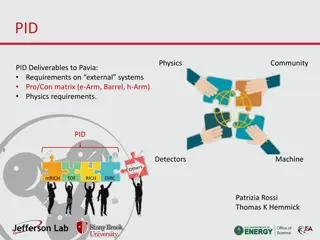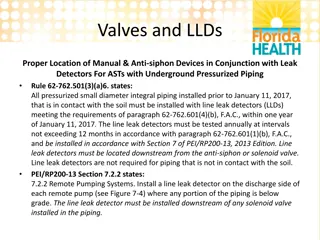Analysis Meeting on Cross-talk and Shaping Time in Particle Detectors
This analysis meeting discusses the relation between cross-talk and shaping time in particle detectors. It covers topics such as Ramo-Shockley theorem, weighting field in parallel plate geometry, induction in Micromegas, and signal processing challenges. Understanding the impact of electronics integration time on signal detection and differentiation is crucial for optimizing detector performance.
Download Presentation

Please find below an Image/Link to download the presentation.
The content on the website is provided AS IS for your information and personal use only. It may not be sold, licensed, or shared on other websites without obtaining consent from the author.If you encounter any issues during the download, it is possible that the publisher has removed the file from their server.
You are allowed to download the files provided on this website for personal or commercial use, subject to the condition that they are used lawfully. All files are the property of their respective owners.
The content on the website is provided AS IS for your information and personal use only. It may not be sold, licensed, or shared on other websites without obtaining consent from the author.
E N D
Presentation Transcript
LCTPC 10th analysis meeting Relation between cross-talk and shaping time P. Colas
Induction in MPGDs Ramo-Shockley theorem: The influence is distributed according to the field lines. Following slides taken from W. Riegler s AIDA tutorial at Frascati.
Weighting Field for a Strip in a Parallel Plate Geometry D w Weighting Field: 3 W. Riegler/CERN
Weighting Field for a Strip in a Parallel Plate Geometry v D w I(t,x) = -e0*Ez[x,D-v*t]*v When all charges have arrived at the electrodes the induced charge is equal to the total charge that has arrived at the electrode. If the electronics integration time ~ peaking time ~ shaping time is larger than the time it takes the electron to pass the induction gap, the readout strips that don t receive any charge show zero signal. If the electronics integration time ~ peaking time ~ shaping time is smaller than than the time it takes the electron to pass the induction gap, the readout strips that don t receive any charge show a signal different from zero that is strictly bipolar. 4 W. Riegler/CERN
GEM Signals, Induced Currents v D = 1mm Central Strip First Neighbour w W >> D W=D W=D/2 5 W. Riegler/CERN
GEM Signals v D = 1mm Central Strip First Neighbour w W=D/2 W=D/2 (D=1mm, w=0.5mm) Connecting an amplifier with Peaking Time = 10ns 10% crosstalk ! In case the electronics peaking time is smaller or of similar size as the time the electron takes to pass the induction gap, there is a sizable signal on the neighboring strips that do not even receive charges. First Neighbor Central Strip W=D/2 6 W. Riegler/CERN
Micromega Signal MICROMEGA 3mm 50um/ns v D = 0.1mm 0.1mm 200um/ns I(t,x) = -e0*Exp[ v t]*Ez[x,D-v*t]*v Electrons Electrons movementin the induction gap takes about 0.1mm/v1=0.5ns. Collecting all electrons from the drift gap takes a maximum of 3mm/v1=60ns. The MICROMEGA electron signal has a length of about 50 ns. Typically w>>D cluster size from electron component is dominated by diffusion and not by direct induction. However, ion component has a length of about 100ns Ballistic Deficit for fast electronis (e.g. 10ns peaking time). 7 W. Riegler/CERN
CONCLUSION In conclusion, shaping too short before discriminating or digitizing will result in a large apparent cross-talk between neighbouring pads. This is probably what has been observed with some of the Asian GEM data (see Analysis meeting 9, Ph. Gros)





















